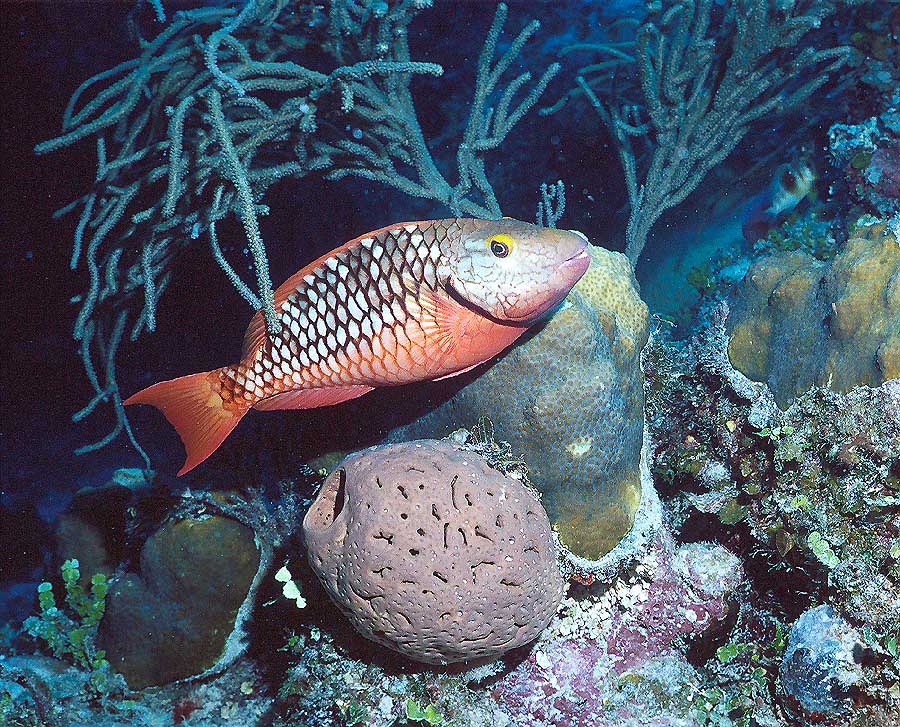


When I went scuba diving the first time, the number and variety of fishes amazed me. To tell the truth, I was really scared to be jumping off a boat into the ocean carrying all that scuba gear. The water was deep and dark, and I just knew there were sharks down there. But that is another story.
I really had no idea what I would see. As we swam down to the reef, the first thing I noticed was that there were fishes everywhere. Big fishes; small fishes; red, blue, and purple fishes; fishes with spots; fishes with stripes; fishes under rocks; fishes swimming in schools; fishes chasing each other. To say it was amazing really doesnít tell you how I felt. I was so amazed that I forgot to be scared!
This picture shows a beautiful Stoplight Parrotfish. On my first dive in the ocean, I saw many Stoplight Parrotfish. They are large fish, up to two feet long. The fish in this picture was about that big. This Stoplight Parrotfish is a female, having very different markings from a male. Notice the very large scales on the side of the fish. Some scales are white and others are gray. Each scale has a black outline. The fish has red fins and a red belly. Red is probably the color that you notice first when you see this fish. Also notice the pattern of lines on its gray face and the yellow spot above its eye.
Parrotfishes get their names from their parrot-like mouths. Parrotfishes have strong teeth that resemble a parrotís bill. These strong, sharp teeth allow the parrotfishes to scrape algae from rocks and corals. Parrotfishes also can bite off pieces of coral, grinding up the coral "skeleton" to eat the tiny coral polyps (say "PAH-lips") that live on the surface of these corals. But the parrotfishes canít digest the ground-up skeleton. The ground-up bits of skeleton pass through their digestive systems to be excreted as "parrotfish poop," or what we usually call "sand." Thatís right, a lot of the sand around islands in the Caribbean came out of the back end of a parrotfish. A single parrotfish can produce hundreds of pounds of sand during its lifetime.
Several common coral-reef animals surround this Stoplight Parrotfish. A Loggerhead Sponge is the large gray ball below the parrotfish. This sponge is over one foot in diameter. The yellow "rock" behind the parrotfish is actually a species of Star Coral. And the branches of a Sea Rod Coral reach into the water above the Star Coral, perhaps providing some shelter for this parrotfish. If you have sharp eyes, you may have noticed the small brown-and-white Barred Hamlet, a fish about 9 inches long that is swimming away from us just in front of this parrotfish.
- Can you guess why a female Stoplight Parrotfish is colored so brightly? Why do you suppose it doesnít have camouflage colors?
- Learn about another species of parrotfish, the Princess Parrotfish, on the ReefNews website
Which is bigger, a Princess Parrotfish or a Stoplight Parrotfish?
This story first appeared in the e-ReefNews e-mail newsletter, Volume 1 number 12.
To subscribe to this free newsletter, check out the e-ReefNews subscription page.
You can order the entire e-ReefNews Volume 1 on CD-ROM, from the ReefNews Online Catalog.
Tessa Dowell took this picture using a Nikonos V with 28mm lens and SB105 strobe.